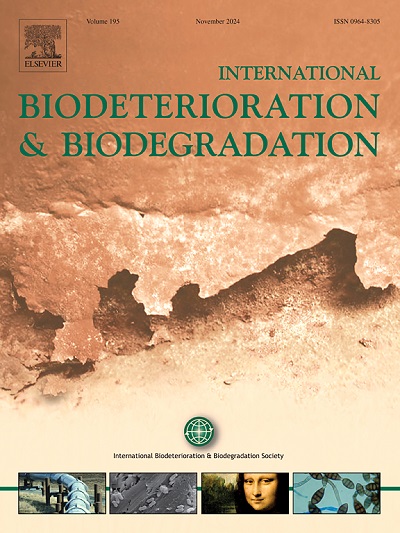厌氧氨氧化污泥富集过程的机理及传质动力学
IF 4.1
2区 环境科学与生态学
Q2 BIOTECHNOLOGY & APPLIED MICROBIOLOGY
International Biodeterioration & Biodegradation
Pub Date : 2025-06-06
DOI:10.1016/j.ibiod.2025.106140
引用次数: 0
摘要
厌氧氨氧化颗粒污泥(AnGS)富集的传质动力学对优化废水中氨(NH4+)的去除具有重要意义。在连续上流式污泥床厌氧氨氧化反应器(CUSBAR)实验中监测了147天的AnGS富集情况,并使用广义Fulazzaky方程进行模拟,以预测潜在的机制和传质动力学。从初始NH4+浓度为30.9 mg/L开始,在63 d的时间内,细菌的NH4+去除率经历了四个不同的阶段。实验第147天,CUSBAR工艺的处理效率达到84.97%,NH4+初始浓度由30.9 mg/L提高到75.0 mg/L。内部传质率(IMT)和整体传质率几乎相同,且显著高于外部传质率(EMT),表明EMT是主要的传质阻力。NH4+去除率与IMT速率之间的正相关关系为研究147天富集期AnGS发育的动态响应提供了有价值的见解。本研究结果提高了AnGS作为未来CUSBAR工艺应用的接种剂的可用性,扩展了厌氧氨氧化脱氮技术的知识库和参考文献。本文章由计算机程序翻译,如有差异,请以英文原文为准。

Mechanisms and mass transfer kinetics of anammox during sludge enrichment
Mass transfer kinetics for enrichment of anammox granular sludge (AnGS) is important for optimizing the removal of ammonium (NH4+) from wastewater. AnGS enrichment was monitored over 147 days in a continuous upflow sludge bed anammox reactor (CUSBAR) experiment, which was simulated using Generalized Fulazzaky equations to predict the underlying mechanisms and mass transfer kinetics. The removal efficiency of NH4+ followed the bacterial growth progressed through four distinct phases over 63 days, starting with an initial NH4+ concentration of 30.9 mg/L. The CUSBAR process achieved a performance of 84.97 % on the 147th day of the experiment, with the initial NH4+ concentration increased from 30.9 to 75.0 mg/L. The internal mass transfer (IMT) and global mass transfer rates were nearly identical and significantly higher than the external mass transfer (EMT) rate, indicating that EMT was the dominant resistance to mass transfer. The positive correlation between NH4+ removal efficiency and IMT rate provides valuable insights into the dynamic response of AnGS development during the 147-day enrichment period. This study's findings enhance the availability of AnGS as inocula for future CUSBAR process applications, expanding the knowledge base and references in anammox-based nitrogen removal technology.
求助全文
通过发布文献求助,成功后即可免费获取论文全文。
去求助
来源期刊
CiteScore
9.60
自引率
10.40%
发文量
107
审稿时长
21 days
期刊介绍:
International Biodeterioration and Biodegradation publishes original research papers and reviews on the biological causes of deterioration or degradation.

 求助内容:
求助内容: 应助结果提醒方式:
应助结果提醒方式:


